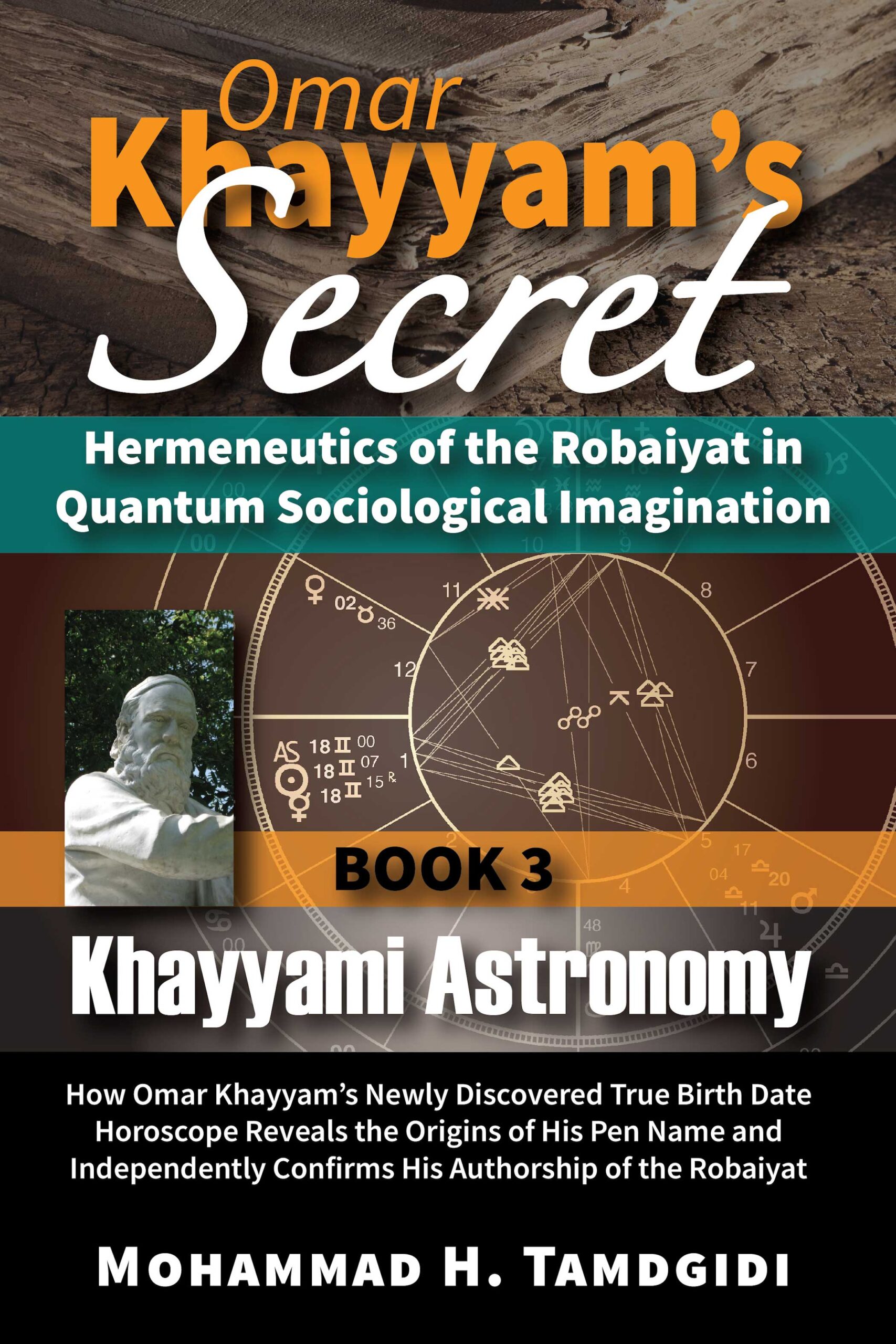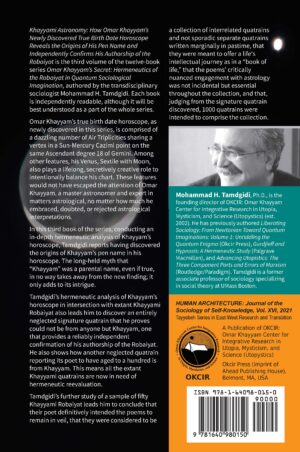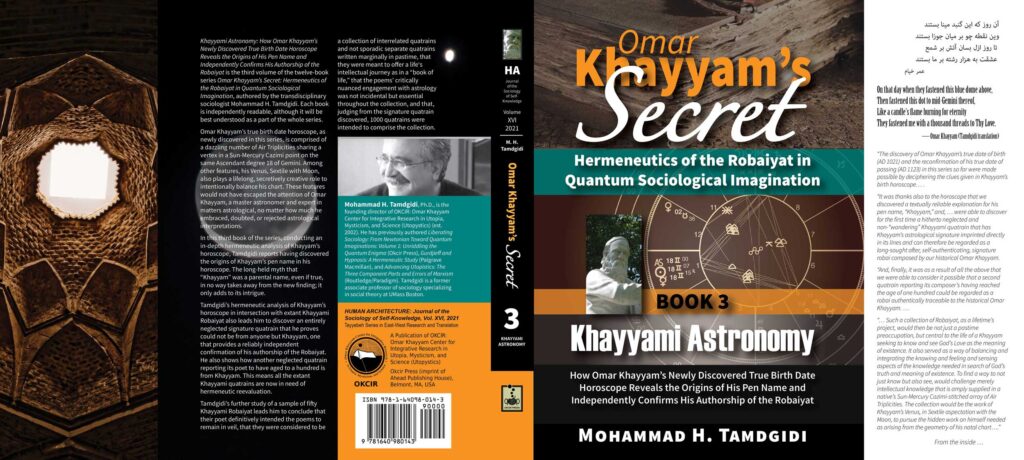Omar Khayyam’s Secret: Hermeneutics of the Robaiyat in Quantum Sociological Imagination: Book 3: Khayyami Astronomy: How Omar Khayyam’s Newly Discovered True Birth Date Horoscope Reveals the Origins of His Pen Name and Independently Confirms His Authorship of the Robaiyat
$69.99 – $99.00
In this book of his Omar Khayyam’s Secret series, Mohammad H. Tamdgidi unveils the horoscope origins of Khayyam’s pen name, pointing to a key signature quatrain that independently confirms his authorship of the Robaiyat.
Publication Date: June 1, 2021
Note: The ePub ebook edition of this title (ISBN: 9781640980167) can be purchased from major online ebook stores worldwide.

All the sections of this publication can be read online by logged-in members of the OKCIR Library with a valid access. In that case click on any section in the table of contents below, and then click on the large PDF icon at the bottom of that page to access the publication section. Alternatively, you can purchase this publication as offered below.
Description
Omar Khayyam’s Secret: Hermeneutics of the Robaiyat in Quantum Sociological Imagination
Book 3: Khayyami Astronomy
How Omar Khayyam’s Newly Discovered True Birth Date Horoscope Reveals the Origins of His Pen Name and Independently Confirms His Authorship of the Robaiyat
Author: Mohammad H. Tamdgidi
Publication Date: June 1, 2021
Human Architecture: Journal of the Sociology of Self-Knowledge (ISSN: 1540-5699)
Volume XVI, 2021, Monograph Series: Tayyebeh Series in East-West Research and Translation
Description
Omar Khayyam’s Secret: Hermeneutics of the Robaiyat in Quantum Sociological Imagination is a twelve-book series of which this book is the third volume, subtitled Khayyami Astronomy: How Omar Khayyam’s Newly Discovered True Birth Date Horoscope Reveals the Origins of His Pen Name and Independently Confirms His Authorship of the Robaiyat. Each book is independently readable, although it will be best understood as a part of the whole series.
In the overall series, the transdisciplinary sociologist Mohammad H. Tamdgidi shares the results of his decades-long research on Omar Khayyam, the enigmatic 11th/12th centuries Persian Muslim sage, philosopher, astronomer, mathematician, physician, writer, and poet from Neyshabour, Iran, whose life and works still remain behind a veil of deep mystery. Tamdgidi’s purpose has been to find definitive answers to the many puzzles still surrounding Khayyam, especially regarding the existence, nature, and purpose of the Robaiyat in his life and works. To explore the questions posed, he advances a new hermeneutic method of textual analysis, informed by what he calls the quantum sociological imagination, to gather and study all the attributed philosophical, religious, scientific, and literary writings of Khayyam.
Omar Khayyam’s true birth date horoscope, as newly discovered in this series, is comprised of a dazzling number of Air Triplicities sharing a vertex on a Sun-Mercury Cazimi point on the same Ascendant degree 18 of Gemini. Among other features, his Venus, Sextile with Moon, also plays a lifelong, secretively creative role to intentionally balance his chart. These features would not have escaped the attention of Omar Khayyam, a master astronomer and expert in matters astrological, no matter how much he embraced, doubted, or rejected astrological interpretations.
In this third book of the series, conducting an in-depth hermeneutic analysis of Khayyam’s horoscope, Tamdgidi reports having discovered the origins of Khayyam’s pen name in his horoscope. The long-held myth that “Khayyam” was a parental name, even if true, in no way takes away from the new finding; it only adds to its intrigue.
Tamdgidi’s hermeneutic analysis of Khayyam’s horoscope in intersection with extant Khayyami Robaiyat also leads him to discover an entirely neglected signature quatrain that he proves could not be from anyone but Khayyam, one that provides a reliably independent confirmation of his authorship of the Robaiyat. He also shows how another neglected quatrain reporting its poet to have aged to a hundred is from Khayyam. This means all the extant Khayyami quatrains are now in need of hermeneutic reevaluation.
Tamdgidi’s further study of a sample of fifty Khayyami Robaiyat leads him to conclude that their poet definitively intended the poems to remain in veil, that they were considered to be a collection of interrelated quatrains and not sporadic separate quatrains written marginally in pastime, that they were meant to offer a life’s intellectual journey as in a “book of life,” that the poems’ critically nuanced engagement with astrology was not incidental but essential throughout the collection, and that, judging from the signature quatrain discovered, 1000 quatrains were intended to comprise the collection.
Oddly it appears that, after all, “The Khayyam who stitched his tents of wisdom” was a trope that had its origins in Omar Khayyam’s horoscope heavens.
About the Author
Mohammad H. Tamdgidi, Ph.D., is the founding director and editor of OKCIR: Omar Khayyam Center for Integrative Research in Utopia, Mysticism, and Science (Utopystics) and its journal, Human Architecture: Journal of the Sociology of Self-Knowledge (ISSN: 1540-5699), which have served since 2002 to frame his independent research, pedagogical, and publishing initiatives. He is a former associate professor of sociology specializing in social theory at UMass Boston and has taught sociology at SUNY-Binghamton and SUNY-Oneonta.
Besides his currently in progress work published in the book series Omar Khayyam’s Secret: Hermeneutics of the Robaiyat in Quantum Sociological Imagination (Okcir Press), Tamdgidi has previously authored Liberating Sociology: From Newtonian Toward Quantum Imaginations: Volume 1: Unriddling the Quantum Enigma (2020, Okcir Press), Gurdjieff and Hypnosis: A Hermeneutic Study (2009, Palgrave Macmillan), and Advancing Utopistics: The Three Component Parts and Errors of Marxism (2007, Routledge/Paradigm). He has published numerous peer reviewed articles and chapters and edited more than thirty journal issues.
Tamdgidi holds a Ph.D. and M.A. in sociology in conjunction with a graduate certificate in Middle Eastern studies from Binghamton University (SUNY). He received his B.A. in architecture from U.C. Berkeley, following enrollment as an undergraduate student of civil engineering in the Technical College of the University of Tehran, Iran.
His areas of scholarly and practical interest are the sociology of self-knowledge, human architecture, and utopystics-three fields of inquiry he invented in his doctoral studies and has since pursued as respectively intertwined theoretical, methodological and applied fields of inquiry altogether contributing to what he calls the quantum sociological imagination. His research, teaching, and publications have been framed by an interest in understanding how world-historical social structures and personal selves constitute one another. This line of inquiry has itself been a result of his longstanding interest in understanding the underlying causes of failures of the world’s utopian, mystical, and scientific movements in bringing about a just global society.
It was during his undergraduate studies at U.C. Berkeley and in the course of his mentorship by the painter and design architect Jesse Reichek (1916-2005) that Tamdgidi’s notion and project “human architecture” was born. During his graduate studies at SUNY-Binghamton, he was mentored in methods, theory, and world-systems studies by Terence K. Hopkins (1928-1997) and Immanuel Wallerstein (1930-2019), and further in dialectics by Dale Tomich and on space and society by Anthony D. King, amid a uniquely autonomous and flexible transdisciplinary Graduate Program in Sociology founded by T. K. Hopkins.
Omar Khayyam’s Secret: Hermeneutics of the Robaiyat in Quantum Sociological Imagination: Book 3: Khayyami Astronomy: How Omar Khayyam’s Newly Discovered True Birth Date Horoscope Reveals the Origins of His Pen Name and Independently Confirms His Authorship of the Robaiyat
Published by: Okcir Press (an imprint of Ahead Publishing House) • Belmont, Massachusetts • First Edition: June 1, 2021
400 pages • 6×9 inches • Includes references, illustrations, bibliography, and index
Library of Congress Control Number (LCCN): 2021906826
ISBN: 9781640980143 (hard cover with dust jacket: alk. paper)
ISBN: 9781640980150 (soft cover: alk. paper)
ISBN: 9781640980167 (ePub ebook)
ISBN: 9781640980174 (PDF ebook)
CITATION: Tamdgidi, Mohammad H. 2021. Omar Khayyam’s Secret: Hermeneutics of the Robaiyat in Quantum Sociological Imagination: Book 3: Khayyami Astronomy: How Omar Khayyam’s Newly Discovered True Birth Date Horoscope Reveals the Origins of His Pen Name and Independently Confirms His Authorship of the Robaiyat. (Human Architecture: Journal of the Sociology of Self-Knowledge: Vol. XVI, 2021. Tayyebeh Series in East-West Research and Translation.) Belmont, MA: Okcir Press.
Where to Purchase this Book: The various editions of this volume can be ordered from the Okcir Store and all major online bookstores worldwide (such as Amazon, Barnes&Noble, Google Play, and others).
Table of Contents
Omar Khayyam’s Secret: Hermeneutics of the Robaiyat in Quantum Sociological Imagination: Book 3: Khayyami Astronomy: How Omar Khayyam’s Newly Discovered True Birth Date Horoscope Reveals the Origins of His Pen Name and Independently Confirms His Authorship of the Robaiyat
About the Author—viii
Acknowledgments—xix
1. Why Not Just Offer A Date of Birth?—32
2. Was Khayyam Known in the Past to Have Died A Centenarian?—41
3. Khayyam’s Horoscope as an Astrological Bread Crumb—45
1. An Overview of the Purpose of Astrological Analysis—54
2. The Aspectations of Khayyam’s Reported Horoscope—57
3. Khayyam’s Horoscope in Light of Khaqani’s Story—71
4. Comparing Khayyam’s Reported Horoscope With That Erroneously Found by Swāmī Govinda Tīrtha—75
5. The Question of Orbs in Exploring Khayyam’s Reported Horoscope—78
6. Where in the Chart Are the Moon, Mars, Venus, and Saturn?: A Dazzling Chart of Air Triplicities and More in the Broader Chart—81
1. Explaining the Table of Basic Features for the Hermeneutic Analysis of Khayyam’s Reported Horoscope—102
2. Notes on Razi’s House System Definitions in the Historical Context of Khayyam’s Time—105
3. Other Astrological Interpretive Issues for Consideration in the Historical Context of Khayyam’s Time—114
4. Notes on Astrological Interpretive Tools Used Today—126
1. Outlines for A Hermeneutic Astrological Interpretation of Khayyam’s Natal Chart: Discovering the Origins of Khayyam’s Pen Name—133
2. What Standardized Interpretations Contribute to Hermeneutic Astrological Interpretations of Khayyam’s Horoscope, Reconsidered in Light of Razi’s House Definitions—150
3. Horoscope as A Map of the Native’s Cultural Belief in His or Her Own Potential Psyche at Birth—166
1. The Case of A Very Unique, Yet Hitherto Entirely Ignored, Khayyami Quatrain—180
2. Who Was Abu Said Abol-Kheyr and to What Extent Could He Have Been Interacting with Khayyam as A Contemporary?—187
3. Comparing the Khayyami Quatrain and Its “Vagrant” Found in the Collection of Abu Said Abol-Kheyr—193
4. The Signature Robai of Khayyam: Discovering the “Holy Grail,” the “Jamsheed’s Cup,” the “Sar-Nakh,” and the “Tip of the Iceberg” of Omar Khayyam’s Robaiyat—200
1. Contextual Classificatory and Citation Clarifications of the Different “Versions” of the “Hundred Years Test” Quatrain—219
2. Turning to the Substantive Content of the “Hundred Years Test” Quatrain, Line by Line—227
3. Bringing the Lines Together to Make Sense of the Overall Quatrain In Light of Various Interpretive and Contextual Probabilities—240
Book 3 Index—361
List of Figures
Figure II.1: The Whole Sign Natal Charts for Khayyam’s Birth on June 10 (Gregorian, or June 4, Julian), AD 1021, For Seven Known Planets, AS, MC, and Their Aspectations—59
Figure II.2: The Whole Sign Natal Chart for Khayyam’s Birth on June 10 (Greg., June 4, Julian), AD 1021, at Sunrise, for Seven Known Planets, AS, MC, And Their Aspectations—63
Figure II.3: The Whole Sign Natal Chart for Khayyam’s Birth on June 10 (Greg., June 4, Julian), AD 1021, Including All the Ten Planets, AS, MC, And Their Aspectations—64
Figure II.4: The Whole Sign Natal Charts for Khayyam: All Astrological Symbols (Top) and Just For Seven Known Planets, AS, MC, and Aspectations in Sidereal Setting (Bottom)—67
Figure II.5: The Whole Sign Natal Charts for Khayyam’s Birth on June 10 (Greg., June 4, Jul.), AD 1021, For Seven Known Planets, AS, MC, and their Aspectations —73
Figure II.6: Horoscope Chart for Tīrtha’s Suggested Date May 24, AD 1048, 4:48:00 a.m., Gregorian Calendar (May 18, 1048 Julian Calendar), Neyshabour, Iran—77
Figure II.7: The Whole Sign Natal Charts for Khayyam’s Birth on June 10 (Greg., June 4, Jul.), AD 1021, Including All Seven Planets (without AS, MC points) and their Aspectations—82
List of Tables
Table III.1: The Standard (According to Astrological Systems Prevalent in Khayyam’s Time) and Horoscope-Specific Map of Houses, Signs, Planets, and Aspectations of Omar Khayyam’s Natal Chart in the Whole Sign House System for the Four Minutes Period at Sunrise During Which He Was Born on June 10 (Gregorian, June 4 Julian), AD 1021, in Neyshabour, Iran—90
Table III.2: Razi’s/Biruni’s Year Periodizations of Firdaria (p. 93) and Khayyam’s Life Events—120
Table III.3: How Planets Regard Each Other in Traditional Astrology According to Razi (p. 93)—124







